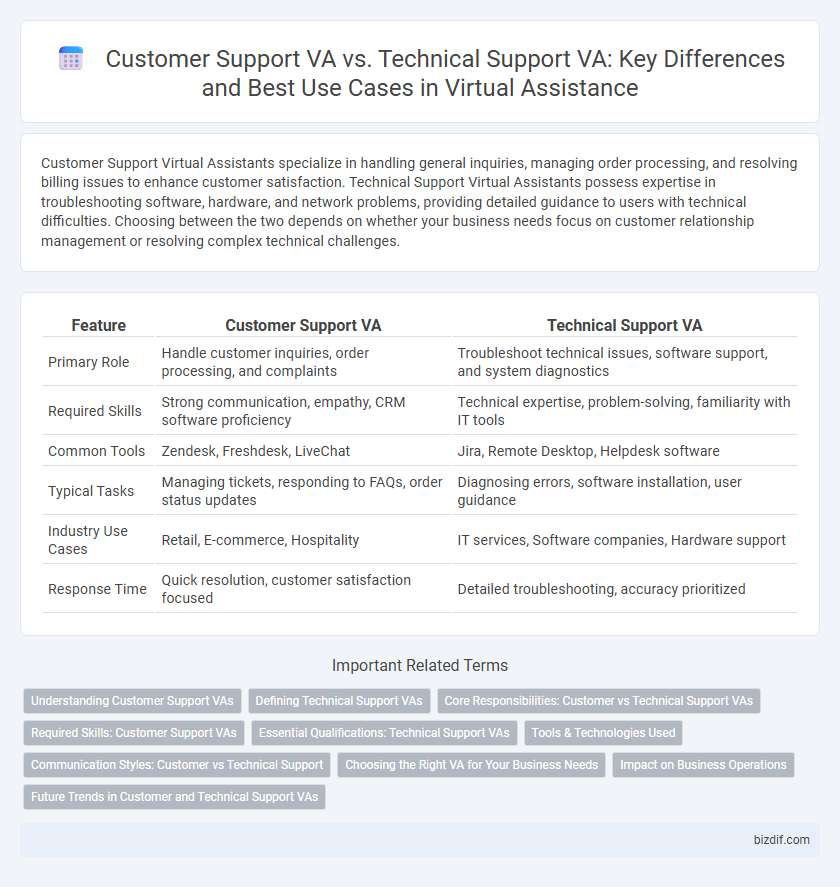Customer Support Virtual Assistants specialize in handling general inquiries, managing order processing, and resolving billing issues to enhance customer satisfaction. Technical Support Virtual Assistants possess expertise in troubleshooting software, hardware, and network problems, providing detailed guidance to users with technical difficulties. Choosing between the two depends on whether your business needs focus on customer relationship management or resolving complex technical challenges.
Table of Comparison
| Feature | Customer Support VA | Technical Support VA |
|---|---|---|
| Primary Role | Handle customer inquiries, order processing, and complaints | Troubleshoot technical issues, software support, and system diagnostics |
| Required Skills | Strong communication, empathy, CRM software proficiency | Technical expertise, problem-solving, familiarity with IT tools |
| Common Tools | Zendesk, Freshdesk, LiveChat | Jira, Remote Desktop, Helpdesk software |
| Typical Tasks | Managing tickets, responding to FAQs, order status updates | Diagnosing errors, software installation, user guidance |
| Industry Use Cases | Retail, E-commerce, Hospitality | IT services, Software companies, Hardware support |
| Response Time | Quick resolution, customer satisfaction focused | Detailed troubleshooting, accuracy prioritized |
Understanding Customer Support VAs
Customer Support Virtual Assistants specialize in managing customer inquiries, resolving order issues, and providing product information to enhance client satisfaction. They utilize CRM software and communication platforms to ensure timely and efficient service across multiple channels. Their primary goal is to maintain positive customer relationships, reduce response times, and improve overall user experience.
Defining Technical Support VAs
Technical Support Virtual Assistants specialize in resolving technical issues related to software, hardware, and IT systems, providing in-depth troubleshooting and product-specific guidance. They possess expertise in diagnosing software bugs, network problems, and system errors, ensuring seamless technology operations for clients. Their role often includes managing ticketing systems, escalating complex issues to engineers, and delivering detailed technical documentation.
Core Responsibilities: Customer vs Technical Support VAs
Customer Support Virtual Assistants primarily handle client inquiries, manage order processing, and resolve billing issues to enhance customer satisfaction and retention. Technical Support Virtual Assistants focus on troubleshooting software problems, guiding users through technical setups, and providing solutions for hardware malfunctions to ensure optimal product performance. Both roles require strong communication skills but differ significantly in technical knowledge and problem-solving approaches.
Required Skills: Customer Support VAs
Customer Support Virtual Assistants require excellent communication skills, empathy, and problem-solving abilities to handle inquiries and resolve issues effectively. Proficiency in CRM software, multitasking, and maintaining a positive customer experience are essential for managing diverse client needs. Strong interpersonal skills and adaptability enable Customer Support VAs to address a wide range of customer concerns efficiently.
Essential Qualifications: Technical Support VAs
Technical Support Virtual Assistants require advanced IT knowledge, including proficiency in troubleshooting software, hardware, and network issues. They must possess certifications such as CompTIA A+, Microsoft Certified Professional, or Cisco CCNA to validate their technical expertise. Strong problem-solving skills combined with the ability to communicate complex technical information clearly are essential qualifications for effective technical support VAs.
Tools & Technologies Used
Customer Support VAs primarily use CRM platforms like Zendesk, Freshdesk, and Salesforce to manage customer interactions, ticketing systems, and knowledge bases. Technical Support VAs rely heavily on remote desktop tools such as TeamViewer and LogMeIn, as well as diagnostic software and specialized troubleshooting platforms like Jira Service Management. Both roles utilize communication tools like Slack, Zoom, and email clients to ensure seamless interaction with customers and internal teams.
Communication Styles: Customer vs Technical Support
Customer Support Virtual Assistants excel in empathetic and clear communication, focusing on resolving inquiries with a friendly tone that ensures customer satisfaction and trust. Technical Support Virtual Assistants use precise, detail-oriented language tailored to diagnose and troubleshoot complex issues, often employing industry-specific terminology to convey solutions effectively. Both roles require adaptive communication styles that align with the distinct needs of customer service and technical problem-solving environments.
Choosing the Right VA for Your Business Needs
Customer Support VAs excel in managing client interactions, handling inquiries, and ensuring customer satisfaction, making them ideal for businesses focused on relationship management and service quality. Technical Support VAs specialize in troubleshooting, software guidance, and resolving technical issues, suited for companies requiring expertise in IT and product support. Selecting the right VA depends on your business's primary needs--prioritize customer engagement for Sales and retention, or technical proficiency for product and system assistance.
Impact on Business Operations
Customer Support Virtual Assistants handle inquiries, process orders, and resolve common issues, enhancing customer satisfaction and streamlining communication channels. Technical Support Virtual Assistants diagnose technical problems, provide troubleshooting guidance, and escalate complex issues, reducing downtime and improving system reliability. Both roles optimize business operations by ensuring efficient problem resolution and maintaining consistent service quality.
Future Trends in Customer and Technical Support VAs
Customer Support virtual assistants increasingly integrate AI-driven sentiment analysis and natural language processing to enhance personalized interactions and resolve inquiries faster. Technical Support VAs evolve by leveraging machine learning algorithms for proactive issue detection and automated troubleshooting across complex IT systems. Future trends emphasize hybrid VA models combining customer empathy with advanced technical problem-solving to improve user experience and operational efficiency.
Customer Support VA vs Technical Support VA Infographic

 bizdif.com
bizdif.com